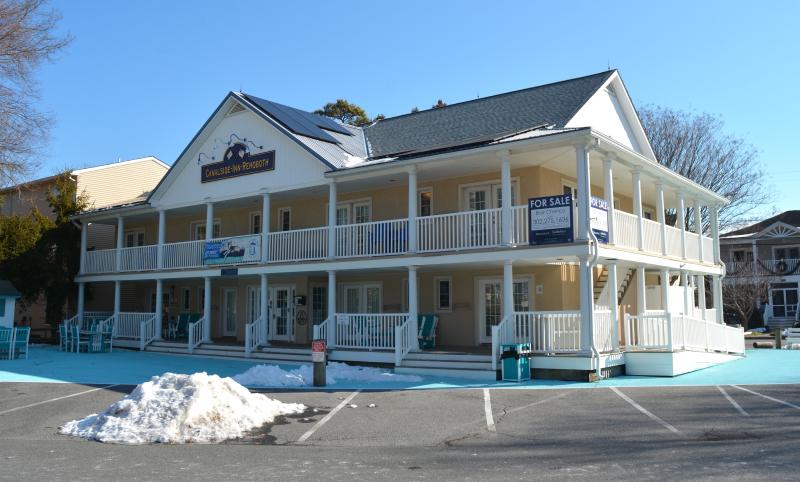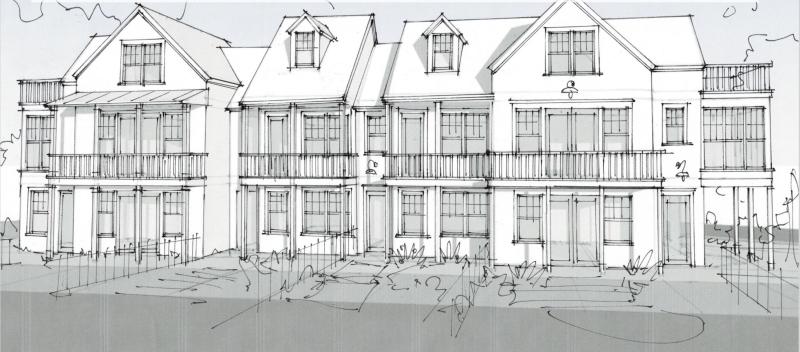The owners of the Canalside Inn in Rehoboth Beach have proposed a redevelopment that would covert the property from a 13-room inn to four townhomes.
The inn has been in existence for many years. The property is part of 300,000 square feet of land along the Lewes-Rehoboth Canal that was rezoned from commercial to residential in 2009. At the time, public sentiment encouraged the lot for the inn to remain commercial, but the city officials rezoned it anyway.
The inn is currently owned by Dr. Bryan Deptula and Kristen Deptula, who bought it in 2019. The Deptulas listed it for sale in 2024.
Bryan and developer Sean Ruppert, owner of Maryland-based OPaL Design + Build, made a presentation Jan. 24 to the Rehoboth Beach Planning Commission to gauge the commission’s interest in moving forward with the proposed redevelopment.
Changing this property from an inn to a residential use would eliminate some of the problems that currently exist, like the number of car trips, noise complaints and concerns of neighbors who want the neighborhood’s character to remain, said Ruppert. There would also be a substantial increase in trees, he said.
As proposed, there would be four 35-foot-tall, single-family, attached homes, said Ruppert. The two interior homes would be about 2,100 square feet, with three bedrooms above ground and a fourth in the basement, while the end units would be the same bedroom count, but be about 400 square feet larger, he said.
The lot is currently zoned R-2, which allows for a number of different styles of residential construction. Rupert said what’s designed seems to fit the zone.
To move forward, the project would likely need a number of variances from the board of adjustment.
Ruppert said the floor-to-area ratio exceeds the 2.0 that’s allowed in code, the lot coverage is slightly over the 40% allowed in code; the project does not meet the 5,000-square-foot-per-dwelling-unit threshold and setbacks are encroached upon. He said he thought if the project were to move forward, the lot coverage and setback issues could probably be addressed in the design phase.
The proposed project was met with general optimism from the planning commission, but members also recognized there were issues.
Commissioner Susan Stewart said basements are counted against FAR, which could make the FAR problem worse. It looks nice, but there are some challenges, she said.
Commissioner Susan Gay said city occupancy code allows a residential dwelling to have two people per bedroom, plus two. If all four townhomes have four bedrooms, it would be 40 people, which is more than the inn has right now, she said.
Speaking to the 5,000-square-foot lot requirement per dwelling unit, Gay said code was put in place 20 years ago by referendum specifically to reduce density and the number of houses on a lot because there had been a number of townhouse developments. It was put there purposely, but she can’t begin to predict what the board of adjustment would say, she said.
Commissioner John Dewey said he can’t help but think the surrounding neighbors would prefer to see appropriately designed townhomes. He said he would like to see this developed, but there are gaps in code.
Dewey said the R-2 zone allows for all sorts of residential uses, but he couldn’t find anything other than single-family house data. This raises all kinds of concerns, because it means city code is incomplete and silent on the mathematics for what can be built in an R-2 zone, he said.
Following the discussion, Ruppert said he and the Deptulas will consult their attorney before making any decisions on how they’ll move forward.
Editor’s note: This story has been updated to accurately attribute comments made by planning commissioner John Dewey, not property owner Bryan Deptula.
Chris Flood has been working for the Cape Gazette since early 2014. He currently covers Rehoboth Beach and Henlopen Acres, but has also covered Dewey Beach and the state government. He covers environmental stories, business stories, random stories on subjects he finds interesting and has a column called ‘Choppin’ Wood’ that runs every other week. Additionally, Chris moonlights as the company’s circulation manager, which primarily means fixing boxes during daylight hours that are jammed with coins, but sometimes means delivering papers in the middle of the night. He’s a graduate of the University of Maine and the Landing School of Boat Building & Design.























































